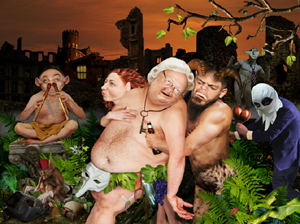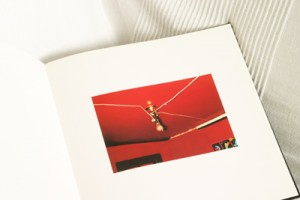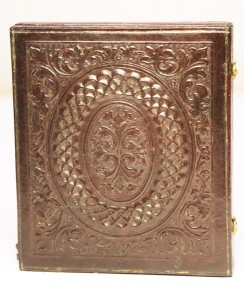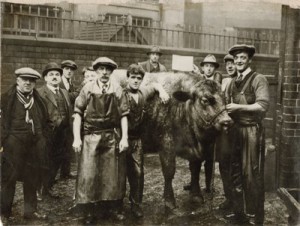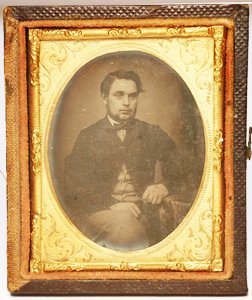Home Site
Follow us on twitter
Find us on Facebook
-
Recent Posts
Categories
Archives
The Candidate
The Candidate is the second image in our series entitled ‘The Procession’.Inspired by the painting ‘Drunken Silenus supported by Satyrs’ – attributed to Anthony van Dyke – now hanging in the National Gallery, London.
The original premise of the drunken teacher assisted and encouraged by his faithful followers mixed with Holbein’s ‘Chairing the Candidate’ (which seemed appropriate considering the election), provided an ideal opportunity to comment on the changing society.
In our image Silenus becomes the drunken victim of a pub crawl, winding his way home from celebrating his recent candidacy while unaware that he is being manipulated by his retinue – each one has their own agenda.
The ruined city in the background testifies to the changing values of the new social order and their lack of need for the old structures.
Posted in Work in progress
Leave a comment
Inspiration from the masters
I’ve often wondered where Francis Bacon’s inspiration for the figures in his 1944 painting ‘Three figures at the base of a crucifiction’ came from,
then I noticed the strange beast in Bosch’s ‘The Temptations of Saint Anthony’
Posted in Art
Leave a comment
Suicide body hidden in tree for 29 years
METRO April 7 2009
By Jo Steele
“When Paul Ludwig committed suicide, he did not want his distressed family to find his body.
Suffering from cancer, he left a note at home saying: ‘Don’t look for me – you won’t find me.’
The 69-year-old then climbed a tree, tied himself to it and shot himself with a rifle, which he’d lashed to his body to stop it falling to the ground.
And there he stayed, undiscovered, for 29 years. Then, Sebastian Gunther and Stefanie Bauer, both 20, were taking a romantic stroll in a forest when they spotted a bone in the bushes and notified the police.
‘once in the woods, they also found a hip fitted with two artificial joints – so we knew it was human remains,’ said Mr Gunther. When officers looked up they saw the skeleton nearly 12m (40ft) above them in a fir tree in Bruckberg, southern Germany.
‘With two artificial hips, I have no idea how he managed to climb up the tree. It wasn’t so high, I guess, 30 years ago,’ said Mr Ludwig’s nephew, Klaus Kiefl, 39. Bavarian police believe the ropes got tighter as the tree grew and eventually severed the arm and leg bones, which fell to the ground.
Posted in Weird Stuff
Leave a comment
William Eggleston
I was pleasantly surprised to turn on the T V and come across Alan Yentobs Imagine on William Eggleston. Entitled ‘The colourful Mr Eggleston’ – if you know of his work it is an obvious one, in that he is the fore father of colour photography, revered by all photographers as an outstanding artist, still prolific and rebellious in his 70s.
The title also refers to his rather unconvential life, at odds with his quiet demeanour, here is a man who enjoyed drinking, guns and women. I was eager for more clues.
During the early 70s he hung out with Andy Warhol who introduced him to film using a sony porta pack camera. In Memphis filming in the clubs and bars with infrared he captured his friends described as drunks, geeks and misfits in an unedited film entitled Stranded in Canton, seen as an extension of his unique vision.
His technique is witnessed during the film, quite often with a cigarette in one hand Leica camera in the other, he fleetingly takes a shot, barely composing or looking through the lens. The results are hypnotic, empty yet expectant, something remarkable has been captured. He shoots just once, confident in his democratic choice.
More than one shot creates confusion he remarks.
His approach has always been difficult to pin down, but what I have always found intriguing about the photos, is their sense of menace, the atmosphere they create pulsates with anticipation – a crime scene before the event.
He photographs the mundane and overlooked from unusual viewpoints, forcing the viewer to fill in the rest.
One of Eggleston most iconic photos is of a red ceiling, shot in 1973 Greenwood Mississippi. Eggleston recounts – ‘one evening he was with a group of friends lying on a big bed talking and he just looked up and took a picture, then carried on talking. It was a spontaneous action, something that attracted his eye’.
Later after learning that Eggleston’s best friend T C was murdered there the photo takes on another darker vision.
Eggleston photographs the world around us as if it is the strangest place, surprising us with intrigue in the everyday. We are invited to gather clues and fill in the gaps.
But there is no conclusion, just another piece of evidence that’s the beauty of it.
William Eggleston described as brilliant and strange remains our William S Burroughs of photography.
Posted in Photography
Leave a comment
“looking at eyes that looked at the Emperor”
When Roland Barthes wrote about his experience while viewing a photograph of Napoleon’s youngest brother Jerome in the book Camera Lucida, he “realized then, with an amazement I have not been able to lessen since: “I am looking at eyes that looked at the Emperor.” When I think about my own obsession with photography I’m reminded of Barthes’ “eyes”, and while I share the same fascination I’m not sure what inspires it.
Could it be the “time travel experience” – when viewing a photograph from the past you are looking through a window into a different time. Or maybe in the digital world where our images reside in the computer, is it the physicality of the object itself and what it meant for the original owner? Or is it just the fact that I’m saddened by the way photos are discarded so easily?
Posted in Photography
Leave a comment
Prize Bull
I acquired this photograph the other day because I was intrigued by it. I have no personal relationship to the people in it and only know it was taken in Yorkshire.
It is of a group of men proudly posed with a prize bull. Who’s fathers, husbands, brothers are they? Did they go down the pub to celebrate. Their dress and posture provides a lot of character. Three of the men are butchers – wearing leather aprons and knife sharpners, therefore its a photo of an important prize bull about to be slaughtered, or is it ? What I’m doing is recording evidence from the photo to create a narrative which may or may not be true.
A photograph, captures a moment in time – a time that is always in the past. Between the time of its capture and the present moment there remains an abyss. The photo offers a story without any form of confirmation, maybe thats the intriguing part.
If anyone does know anything about this photo please add comment
Posted in Photography
Leave a comment
First Post
I’ve been intrigued by photography my whole life, recently through working with digital technology, I was drawn back to studying the beginning of photography and the first experiments of capturing an image. The daguerreotype (photo displayed) was one of the earliest forms of photography. Invented by Daguerre, they are copper plates, silvered, exposed and developed in mercury vapours. they are the most fascinating victorian keepsakes.
Posted in Photography
Leave a comment

